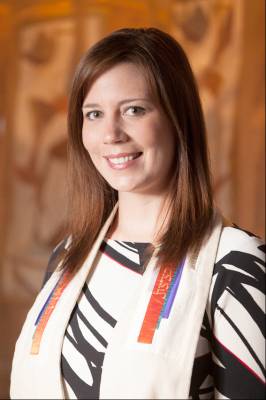
We Jews are good at a lot of things. Talking about God is not one of them. I would even venture to guess that some of us are grateful that our prayers are in Hebrew, so we don’t have to think too hard about what it is that we’re actually saying about God.
It’s less complicated to articulate what we don’t believe. As one of my rabbinic colleagues often tells congregants, “I don’t believe in the same God that you don’t believe in.”
There is something deeply vulnerable in sharing what we do believe. We feel like we’re holding our most deeply held truths up for scrutiny. Maybe we’re embarrassed that we don’t have the language to articulate those beliefs. Better to focus on the tangible ways of being Jewish, we think — like food, holidays, and community.
Parashat Ki Tisa reminds us that we’re not the first generation to struggle with our relationship (or lack thereof) to God. Even after the Israelites experience the miracle of the Exodus, they still struggle to understand the Divine — making a golden idol when they don’t feel God.
And Moses — the man with arguably the most access to God ever; the man who speaks directly with God — even he struggles to understand. After the Burning Bush, after the ten plagues, after the splitting Sea of Reeds, after receiving commandments at Sinai, after all of this, he doesn’t build a Golden Calf, but he does beg God to let him understand the Divine: “If I have truly gained your favor, pray, let me know Your ways so that I may know You” (Exodus 33:13).
How could it be that after all Moses has experienced of God, he still feels as though he does not understand the Divine? Moses’ strange crisis of faith taps into a larger, more universal truth for all of us.
There are moments when we feel deeply connected and purpose-filled. And there are moments when we feel a void.
For me, the moments of connectedness and purpose are moments in which I experience God — when I live the Shema. Others who experience these moments may not use the language of God to describe them. It’s of no importance to me what people call these moments. I take my cue from the scholar Reza Aslan in his recent book, God: A Human History: “I have no interest in trying to prove the existence or nonexistence of God for the simple reason that no proof exists either way. Faith is a choice; anyone who says otherwise is trying to convert you.”1 But I do feel confident that all of us have these moments of connection – whatever we call them. It is part of the human experience.
Personally, I call those purpose-filled moments “God.” But on a daily basis, I am more likely to feel the void — an absence of that purpose and connectedness. Perhaps when God tells Moses in the Torah portion, “You will not be able to see My face, for a person shall not see Me and live,” the message is that we must come to terms with our ability to only happen upon God moments on occasion. We cannot sustain those encounters — it would be too much for us to carry on with our daily lives. There are too many distracting details that require our attention to survive.
But the most beautiful line of the Torah portion for me comes when God responds to Moses, not just with the restrictions on knowing God, but with an invitation, Hinei makom Iti, “See, there is a place near Me” (Exodus 33:21). God invites Moses not to understand God, but to experience God — to be present with God, even if that experience is fleeting.
The invitation of Hinei makom Iti is a play on words. Rashi explains that the word makom, “place,” is another name for God’s Presence. And the Midrash goes further to give us a remarkable theology: “God says, ‘the place is by me,’ not ‘I am the place,’ because God comprises the universe, but the universe does not encompass God” (B’reishit Rabbah 68:8).
God is in the world. But we can easily miss seeing God in the world. We can momentarily know our purpose. But a sustained experience of it is beyond our ability. That fleeting nature of experiencing God is why our ancestors created the Golden Calf after living through the Exodus. It is why Moses begged to know God even after all of his encounters with God.
Each of us has an invitation like the one given to Moses — Hinei makom Iti, “See, there is a place near Me.” It is an invitation for us to remember what we already have known. As Reza Aslan offers, “perhaps, rather than concerning ourselves with trying to form a relationship with God, we should instead become fully aware of the relationship that already exists.” 2
1. Reza Aslan, God: A Human History (NY: Random House, New York: 2017) p. xiv
2. Ibid., Aslan, p. 169
Rabbi Sarah Bassin is the associate rabbi at Temple Emanuel of Beverly Hills, in Beverly Hills, CA and former executive director and board member of NewGround: A Muslim-Jewish Partnership for Change.

In reading Parashat Ki Tisa, Ovadia Sforno commented that the words, Hinei makom Iti, “See, there is a place near Me,” (Exodus 33:21) refer to a specific place described in Talmud, where both Moses and the prophet Elijah stood. From this spot, wrote Sforno, one can actually take in views of God (Sforno on Exodus 33:21-23). I believe that, for us, the phrase may not describe a physical place, at all. Rather than a certain intersection of latitude and longitude, “See, there is a place near Me " may direct us to an intersection of time and practice where we can access divinity.
Innumerable such points are possible in our lives, but there is one place in time — ripe with the possibility for intentional action — to which we return again and again. Precise directions to that particular intersection are provided earlier in the parashah — the last words before God hands Moses two tablets of commandments on Mt. Sinai: V'shamru V'nei Yisrael et HaShabbat… “The people of Israel shall keep the Sabbath … it shall be a sign for all time between Me and the people of Israel” (Exodus 31:16-17).
“Shabbat beckons us to a sense of the holy, to an awareness of the sacred dimensions of life.”1 This is the “place by Me,” accessible to us from all physical geographic locations. It is the place where, weekly, we can experience eternality in time — revisiting the days of Creation and remembering the season of our Redemption — and where we can nurture what we pray might be eternal in ourselves.
With Hinei makom Iti, God may have been pointing Moses to the perfect spot in the cleft in the rock. For the rest of us, spread across the earth, who might wish for a place by God, Ki Tisa directs us, as well. Shabbat can be a place where, as Rabbi Bassin eloquently put it, we can “remember what we already have known.” This, and every, Shabbat, may we find ourselves in just the right place to catch a glimpse of the Eternal.
1. Sidney Greenberg and Jonathan D. Levine, eds., Siddur Hadash (NY: Prayer Book Press of Media Judaica, Inc., 1992), p. 289
Rabbi Michael E. Danziger serves as assistant rabbi at Isaac M. Wise Temple in Cincinnati, OH.
Ki Tisa, Exodus 30:11−34:35
The Torah: A Modern Commentary, pp. 632−662; Revised Edition, pp. 581–606
The Torah: A Women’s Commentary, pp. 495–520
Haftarah, I Kings 18:1-39, The Torah: A Modern Commentary, pp. 722-725 ; Revised Edition, pp. 607-610
Explore Jewish Life and Get Inspired
Subscribe for Emails


